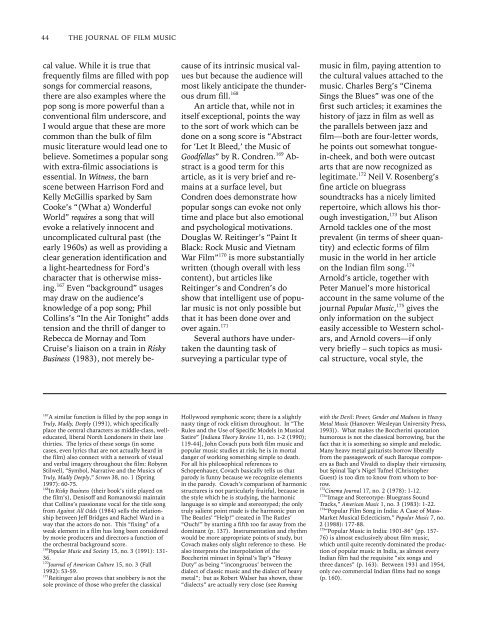Music in Films: A Critical Review of Literature - California State ...
Music in Films: A Critical Review of Literature - California State ...
Music in Films: A Critical Review of Literature - California State ...
Create successful ePaper yourself
Turn your PDF publications into a flip-book with our unique Google optimized e-Paper software.
44 THE JOURNAL OF FILM MUSIC<br />
cal value. While it is true that<br />
frequently films are filled with pop<br />
songs for commercial reasons,<br />
there are also examples where the<br />
pop song is more powerful than a<br />
conventional film underscore, and<br />
I would argue that these are more<br />
common than the bulk <strong>of</strong> film<br />
music literature would lead one to<br />
believe. Sometimes a popular song<br />
with extra-filmic associations is<br />
essential. In Witness, the barn<br />
scene between Harrison Ford and<br />
Kelly McGillis sparked by Sam<br />
Cooke’s “(What a) Wonderful<br />
World” requires a song that will<br />
evoke a relatively <strong>in</strong>nocent and<br />
uncomplicated cultural past (the<br />
early 1960s) as well as provid<strong>in</strong>g a<br />
clear generation identification and<br />
a light-heartedness for Ford’s<br />
character that is otherwise miss<strong>in</strong>g.<br />
167 Even “background” usages<br />
may draw on the audience’s<br />
knowledge <strong>of</strong> a pop song; Phil<br />
Coll<strong>in</strong>s’s “In the Air Tonight” adds<br />
tension and the thrill <strong>of</strong> danger to<br />
Rebecca de Mornay and Tom<br />
Cruise’s liaison on a tra<strong>in</strong> <strong>in</strong> Risky<br />
Bus<strong>in</strong>ess (1983), not merely be-<br />
167<br />
A similar function is filled by the pop songs <strong>in</strong><br />
Truly, Madly, Deeply (1991), which specifically<br />
place the central characters as middle-class, welleducated,<br />
liberal North Londoners <strong>in</strong> their late<br />
thirties. The lyrics <strong>of</strong> these songs (<strong>in</strong> some<br />
cases, even lyrics that are not actually heard <strong>in</strong><br />
the film) also connect with a network <strong>of</strong> visual<br />
and verbal imagery throughout the film: Robynn<br />
Stilwell, “Symbol, Narrative and the <strong>Music</strong>s <strong>of</strong><br />
Truly, Madly Deeply,” Screen 38, no. 1 (Spr<strong>in</strong>g<br />
1997): 60-75.<br />
168<br />
In Risky Bus<strong>in</strong>ess (their book’s title played on<br />
the film’s), Denis<strong>of</strong>f and Romanowski ma<strong>in</strong>ta<strong>in</strong><br />
that Coll<strong>in</strong>s’s passionate vocal for the title song<br />
from Aga<strong>in</strong>st All Odds (1984) sells the relationship<br />
between Jeff Bridges and Rachel Ward <strong>in</strong> a<br />
way that the actors do not. This “fix<strong>in</strong>g” <strong>of</strong> a<br />
weak element <strong>in</strong> a film has long been considered<br />
by movie producers and directors a function <strong>of</strong><br />
the orchestral background score.<br />
169<br />
Popular <strong>Music</strong> and Society 15, no. 3 (1991): 131-<br />
36.<br />
170<br />
Journal <strong>of</strong> American Culture 15, no. 3 (Fall<br />
1992): 53-59.<br />
171<br />
Reit<strong>in</strong>ger also proves that snobbery is not the<br />
sole prov<strong>in</strong>ce <strong>of</strong> those who prefer the classical<br />
cause <strong>of</strong> its <strong>in</strong>tr<strong>in</strong>sic musical values<br />
but because the audience will<br />
most likely anticipate the thunderous<br />
drum fill. 168<br />
An article that, while not <strong>in</strong><br />
itself exceptional, po<strong>in</strong>ts the way<br />
to the sort <strong>of</strong> work which can be<br />
done on a song score is “Abstract<br />
for ‘Let It Bleed,’ the <strong>Music</strong> <strong>of</strong><br />
Goodfellas” by R. Condren. 169 Abstract<br />
is a good term for this<br />
article, as it is very brief and rema<strong>in</strong>s<br />
at a surface level, but<br />
Condren does demonstrate how<br />
popular songs can evoke not only<br />
time and place but also emotional<br />
and psychological motivations.<br />
Douglas W. Reit<strong>in</strong>ger’s “Pa<strong>in</strong>t It<br />
Black: Rock <strong>Music</strong> and Vietnam<br />
War Film” 170 is more substantially<br />
written (though overall with less<br />
content), but articles like<br />
Reit<strong>in</strong>ger’s and Condren’s do<br />
show that <strong>in</strong>telligent use <strong>of</strong> popular<br />
music is not only possible but<br />
that it has been done over and<br />
over aga<strong>in</strong>. 171<br />
Several authors have undertaken<br />
the daunt<strong>in</strong>g task <strong>of</strong><br />
survey<strong>in</strong>g a particular type <strong>of</strong><br />
Hollywood symphonic score; there is a slightly<br />
nasty t<strong>in</strong>ge <strong>of</strong> rock elitism throughout. In “The<br />
Rules and the Use <strong>of</strong> Specific Models <strong>in</strong> <strong>Music</strong>al<br />
Satire” [Indiana Theory <strong>Review</strong> 11, no. 1-2 (1990);<br />
119-44], John Covach puts both film music and<br />
popular music studies at risk; he is <strong>in</strong> mortal<br />
danger <strong>of</strong> work<strong>in</strong>g someth<strong>in</strong>g simple to death.<br />
For all his philosophical references to<br />
Schopenhauer, Covach basically tells us that<br />
parody is funny because we recognize elements<br />
<strong>in</strong> the parody. Covach’s comparison <strong>of</strong> harmonic<br />
structures is not particularly fruitful, because <strong>in</strong><br />
the style which he is study<strong>in</strong>g, the harmonic<br />
language is so simple and stereotyped; the only<br />
truly salient po<strong>in</strong>t made is the harmonic pun on<br />
The Beatles’ “Help!” created <strong>in</strong> The Rutles’<br />
“Ouch!” by start<strong>in</strong>g a fifth too far away from the<br />
dom<strong>in</strong>ant (p. 137). Instrumentation and rhythm<br />
would be more appropriate po<strong>in</strong>ts <strong>of</strong> study, but<br />
Covach makes only slight reference to these. He<br />
also <strong>in</strong>terprets the <strong>in</strong>terpolation <strong>of</strong> the<br />
Boccher<strong>in</strong>i m<strong>in</strong>uet <strong>in</strong> Sp<strong>in</strong>al’s Tap’s “Heavy<br />
Duty” as be<strong>in</strong>g “‘<strong>in</strong>congruous’ between the<br />
dialect <strong>of</strong> classic music and the dialect <strong>of</strong> heavy<br />
metal”; but as Robert Walser has shown, these<br />
“dialects” are actually very close (see Runn<strong>in</strong>g<br />
music <strong>in</strong> film, pay<strong>in</strong>g attention to<br />
the cultural values attached to the<br />
music. Charles Berg’s “C<strong>in</strong>ema<br />
S<strong>in</strong>gs the Blues” was one <strong>of</strong> the<br />
first such articles; it exam<strong>in</strong>es the<br />
history <strong>of</strong> jazz <strong>in</strong> film as well as<br />
the parallels between jazz and<br />
film—both are four-letter words,<br />
he po<strong>in</strong>ts out somewhat tongue<strong>in</strong>-cheek,<br />
and both were outcast<br />
arts that are now recognized as<br />
legitimate. 172 Neil V. Rosenberg’s<br />
f<strong>in</strong>e article on bluegrass<br />
soundtracks has a nicely limited<br />
repertoire, which allows his thorough<br />
<strong>in</strong>vestigation, 173 but Alison<br />
Arnold tackles one <strong>of</strong> the most<br />
prevalent (<strong>in</strong> terms <strong>of</strong> sheer quantity)<br />
and eclectic forms <strong>of</strong> film<br />
music <strong>in</strong> the world <strong>in</strong> her article<br />
on the Indian film song. 174<br />
Arnold’s article, together with<br />
Peter Manuel’s more historical<br />
account <strong>in</strong> the same volume <strong>of</strong> the<br />
journal Popular <strong>Music</strong>, 175 gives the<br />
only <strong>in</strong>formation on the subject<br />
easily accessible to Western scholars,<br />
and Arnold covers—if only<br />
very briefly – such topics as musical<br />
structure, vocal style, the<br />
with the Devil: Power, Gender and Madness <strong>in</strong> Heavy<br />
Metal <strong>Music</strong> (Hanover: Wesleyan University Press,<br />
1993)). What makes the Boccher<strong>in</strong>i quotation<br />
humorous is not the classical borrow<strong>in</strong>g, but the<br />
fact that it is someth<strong>in</strong>g so simple and melodic.<br />
Many heavy metal guitarists borrow liberally<br />
from the passagework <strong>of</strong> such Baroque composers<br />
as Bach and Vivaldi to display their virtuosity,<br />
but Sp<strong>in</strong>al Tap’s Nigel Tufnel (Christopher<br />
Guest) is too dim to know from whom to borrow.<br />
172 C<strong>in</strong>ema Journal 17, no. 2 (1978): 1-12.<br />
173 “Image and Stereotype: Bluegrass Sound<br />
Tracks,” American <strong>Music</strong> 1, no. 3 (1983): 1-22.<br />
174 “Popular Film Song <strong>in</strong> India: A Case <strong>of</strong> Mass-<br />
Market <strong>Music</strong>al Eclecticism,” Popular <strong>Music</strong> 7, no.<br />
2 (1988): 177-88.<br />
175 “Popular <strong>Music</strong> <strong>in</strong> India: 1901-86” (pp. 157-<br />
76) is almost exclusively about film music,<br />
which until quite recently dom<strong>in</strong>ated the production<br />
<strong>of</strong> popular music <strong>in</strong> India, as almost every<br />
Indian film had the requisite “six songs and<br />
three dances” (p. 163). Between 1931 and 1954,<br />
only two commercial Indian films had no songs<br />
(p. 160).

















